Critical Factors Affecting Construction Labor Productivity: A Systematic Review and Meta-Analysis
Abstract
1. Introduction
2. Methodology
2.1. Search Strategies
2.2. Inclusion and Exclusion Criteria
- (1)
- The primary focus of this study must pertain to labor productivity in the construction industry, with a concomitant examination of the factors that influence this productivity;
- (2)
- This study should involve empirical quantitative research analyzing factors impacting CLP.
- (1)
- Studies that exclusively focus on the impact of a singular type of influencing factor on CLP;
- (2)
- Case studies that are qualitative, review-based, or retrospective in nature;
- (3)
- Studies for which the full-text content is unavailable;
- (4)
- Duplicate studies or studies with identical sample data.
2.3. A Literature Selection
2.4. Procedures of Meta-Analysis
2.4.1. Data Collection and Coding
2.4.2. Statistical Model
2.4.3. Heterogeneity
2.4.4. Subgroup Analysis
2.4.5. Sensitivity Analysis
2.4.6. Publication Bias
3. Results
3.1. CF Identification
3.2. Numerical Example
3.3. Meta-Analysis Results
3.3.1. CFs Analysis
3.3.2. Subgroup Analysis
3.3.3. Sensitivity Analysis
4. Discussion
4.1. Discussion on Top CFs
4.2. Theoretical Implications
4.3. Practical Implications
5. Limitation
6. Conclusions
Supplementary Materials
Author Contributions
Funding
Data Availability Statement
Acknowledgments
Conflicts of Interest
References
- Ertuğrul, H.M.; Pirgaip, B. The nexus between construction investment and economic development: Evidence from MENA countries. Construct. Manag. Econ. 2021, 39, 932–947. [Google Scholar] [CrossRef]
- Liu, B.; Gao, Q.; Liang, L.; Sun, J.; Liu, C.; Xu, Y. Ecological relationships of global construction industries in sustainable economic and energy development. Energy 2021, 234, 121249. [Google Scholar] [CrossRef]
- Xu, X.; Wang, Y.; Tao, L. Comprehensive evaluation of sustainable development of regional construction industry in China. J. Clean. Prod. 2019, 211, 1078–1087. [Google Scholar] [CrossRef]
- Van Tam, N. Unveiling global research trends in construction productivity: A scientometric analysis of twenty-first century research. Smart Constr. Sustain. Cities 2024, 2, 2. [Google Scholar] [CrossRef]
- Qi, K.; Owusu, E.K.; Francis Siu, M.-F.; Albert Chan, P.-C. A systematic review of construction labor productivity studies: Clustering and analysis through hierarchical latent dirichlet allocation. Ain Shams Eng. J. 2024, 15, 102896. [Google Scholar] [CrossRef]
- Hwang, B.-G.; Ng, W.J. Project management knowledge and skills for green construction: Overcoming challenges. Int. J. Proj. Manag. 2013, 31, 272–284. [Google Scholar] [CrossRef]
- Golchin Rad, K.; Kim, S.-Y. Factors Affecting Construction Labor Productivity: Iran Case Study. Iran. J. Sci. Technol. Trans. Civ. Eng. 2018, 42, 165–180. [Google Scholar] [CrossRef]
- Durdyev, S.; Mbachu, J. Key constraints to labour productivity in residential building projects: Evidence from Cambodia. Int. J. Construct. Manag. 2018, 18, 385–393. [Google Scholar] [CrossRef]
- Vigneshwar, R.V.K.; Shanmugapriya, S. Investigating the factors affecting construction site productivity—A case of India. Eng. Constr. Archit. Manag. 2023, 30, 963–985. [Google Scholar] [CrossRef]
- Yi, W.; Chan Albert, P.C. Critical Review of Labor Productivity Research in Construction Journals. J. Manag. Eng. 2014, 30, 214–225. [Google Scholar] [CrossRef]
- Naoum, S.G. Factors influencing labor productivity on construction sites. Int. J. Product. Perform. Manag. 2016, 65, 401–421. [Google Scholar] [CrossRef]
- Chen, L.; Chan, A.P.C.; Owusu, E.K.; Darko, A.; Gao, X. Critical success factors for green building promotion: A systematic review and meta-analysis. Build. Environ. 2022, 207, 108452. [Google Scholar] [CrossRef]
- Robles, G.; Stifi, A.; Ponz-Tienda, J.; Gentes, S. Labor Productivity in the Construction Industry—Factors Influencing the Spanish Construction Labor Productivity. Int. J. Civ. Archit. Struct. Constr. Eng. 2014, 8, 999–1008. [Google Scholar]
- Shoar, S.; Banaitis, A. Application of Fuzzy Fault Tree Analysis to Identify Factors Influencing Construction Labor Productivity: A High-Rise Building Case Study. J. Civ. Eng. Manag. 2019, 25, 41–52. [Google Scholar] [CrossRef]
- Gupta, M.; Hasan, A.; Jain Arvind, K.; Jha Kumar, N. Site Amenities and Workers’ Welfare Factors Affecting Workforce Productivity in Indian Construction Projects. J. Constr. Eng. Manag. 2018, 144, 04018101. [Google Scholar] [CrossRef]
- Page, M.J.; McKenzie, J.E.; Bossuyt, P.M.; Boutron, I.; Hoffmann, T.C.; Mulrow, C.D.; Shamseer, L.; Tetzlaff, J.M.; Akl, E.A.; Brennan, S.E.; et al. The PRISMA 2020 statement: An updated guideline for reporting systematic reviews. BMJ 2021, 372, n71. [Google Scholar] [CrossRef]
- Grant, M.J.; Booth, A. A typology of reviews: An analysis of 14 review types and associated methodologies. Health Inf. Libr. J. 2009, 26, 91–108. [Google Scholar] [CrossRef]
- Peters, J.L.; Remmers, T.; Wheeler, A.J.; Murphy, J.; Cummins, V. A systematic review and meta-analysis of GIS use to reveal trends in offshore wind energy research and offer insights on best practices. Renew. Sustain. Energy Rev. 2020, 128, 109916. [Google Scholar] [CrossRef]
- Zhu, J.; Liu, W. A tale of two databases: The use of Web of Science and Scopus in academic papers. Scientometrics 2020, 123, 321–335. [Google Scholar] [CrossRef]
- Levine-Clark, M.; Gil, E. A comparative analysis of social sciences citation tools. Online Inf. Rev. 2009, 33, 986–996. [Google Scholar] [CrossRef]
- Lehrer, E.J.; Wang, M.; Sun, Y.; Zaorsky, N.G. An Introduction to Meta-Analysis. Int. J. Radiat. Oncol. Biol. Phys. 2023, 115, 564–571. [Google Scholar] [CrossRef] [PubMed]
- Hussein, M.; Zayed, T. Critical factors for successful implementation of just-in-time concept in modular integrated construction: A systematic review and meta-analysis. J. Clean. Prod. 2021, 284, 124716. [Google Scholar] [CrossRef] [PubMed]
- Higgins, J.P.T.; Green, S.; Ben Van Den, A. Cochrane Handbook for Systematic Reviews of Interventions. Int. Coach. Psychol. Rev. 2020, 15, 123–125. [Google Scholar] [CrossRef]
- Borenstein, M.; Hedges, L.V.; Higgins, J.P.T.; Rothstein, H.R.; Ben Van Den, A. Introduction to Meta-Analysis. Int. Coach. Psychol. Rev. 2020, 15, 121–122. [Google Scholar] [CrossRef]
- Aghayeva, K.; Ślusarczyk, B. Analytic Hierarchy of Motivating and Demotivating Factors Affecting Labor Productivity in the Construction Industry: The Case of Azerbaijan. Sustainability 2019, 11, 5975. [Google Scholar] [CrossRef]
- Jarkas Abdulaziz, M.; Bitar Camille, G. Factors Affecting Construction Labor Productivity in Kuwait. J. Constr. Eng. Manag. 2012, 138, 811–820. [Google Scholar] [CrossRef]
- El-Gohary Khaled, M.; Aziz Remon, F. Factors Influencing Construction Labor Productivity in Egypt. J. Manag. Eng. 2014, 30, 1–9. [Google Scholar] [CrossRef]
- Gunduz, M.; Abu-Hijleh, A. Assessment of Human Productivity Drivers for Construction Labor through Importance Rating and Risk Mapping. Sustainability 2020, 12, 8614. [Google Scholar] [CrossRef]
- Gurcanli, G.E.; Bilir Mahcicek, S.; Serpel, E.; Attia, S. Factors Affecting Productivity of Technical Personnel in Turkish Construction Industry: A Field Study. Arab. J. Sci. Eng. 2021, 46, 11339–11353. [Google Scholar] [CrossRef]
- Milind Mehta, S.; Chang, S.; Oh, H.J.; Kwon, J.-H.; Kim, S. An Investigation of Construction Project Efficiency: Perception Gaps and the Interrelationships of Critical Factors. Buildings 2022, 12, 1559. [Google Scholar] [CrossRef]
- Bierman, M.; Marnewick, A.; Pretorius, J.H.C. Productivity management in the South African civil construction industry—Factors affecting construction productivity. J. S. Afr. Inst. Civ. Eng. 2016, 58, 37–44. [Google Scholar] [CrossRef]
- Doloi, H. Twinning Motivation, Productivity and Management Strategy in Construction Projects. Eng. Manag. J. 2007, 19, 30–40. [Google Scholar] [CrossRef]
- Kazaz, A.; Ulubeyli, S. Drivers of productivity among construction workers: A study in a developing country. Build. Environ. 2007, 42, 2132–2140. [Google Scholar] [CrossRef]
- Jarkas, A.M.; Al Balushi, R.A.; Raveendranath, P.K. Determinants of construction labour productivity in Oman. Int. J. Construct. Manag. 2015, 15, 332–344. [Google Scholar] [CrossRef]
- Jarkas, A.M.; Kadri, C.Y.; Younes, J.H. A Survey of Factors Influencing the Productivity of Construction Operatives in the State of Qatar. Int. J. Construct. Manag. 2012, 12, 1–23. [Google Scholar] [CrossRef]
- Ohueri, C.C.; Enegbuma, W.I.; Wong, N.H.; Kuok, K.K.; Kenley, R. Labour productivity motivation framework for Iskandar Malaysia. Built Environ. Proj. Asset Manag. 2018, 8, 293–304. [Google Scholar] [CrossRef]
- Ghoddousi, P.; Poorafshar, O.; Chileshe, N.; Hosseini, M.R. Labour productivity in Iranian construction projects. Int. J. Product. Perform. Manag. 2015, 64, 811–830. [Google Scholar] [CrossRef]
- Dixit, S.; Mandal, S.; Thanikal, J.; Saurabh, K. Critical Analysis of Factors Affecting the on-site Productivity in Indian Construction Industry. In Proceedings of the Creative Construction Conference, Ljubljana, Slovenia, 30 June–3 July 2018. [Google Scholar] [CrossRef]
- Sherif, M.H.; Remon, F.A.; Enas, S.M.; Madeha, M.A.; Eman, K.A. Critical Factors Affecting Construction Labor Productivity in Egypt. Am. J. Civ. Eng. 2014, 2, 35–40. [Google Scholar] [CrossRef]
- Jarkas, A.M. Factors influencing labour productivity in Bahrain’s construction industry. Int. J. Construct. Manag. 2015, 15, 94–108. [Google Scholar] [CrossRef]
- Hiyassat, M.A.; Hiyari, M.A.; Sweis, G.J. Factors affecting construction labour productivity: A case study of Jordan. Int. J. Construct. Manag. 2016, 16, 138–149. [Google Scholar] [CrossRef]
- Mahamid, I.; Al-Ghonamy, A.; Aichouni, M. Major Factors Influencing Employee Productivity in the KSA Public Construction Projects. Int. J. Civ. Environ. Eng. 2013, 14, 16–20. [Google Scholar]
- Makulsawatudom, A.; Emsley, M. Critical factors influencing construction productivity in Thailand. In Proceedings of the 10th International CIB Symposium of the W65 Commission on Organisation and Management of Construction: Construction Innovation and Global Competitiveness, Cincinnati, OH, USA, 9–13 September 2002; pp. 1446–1456. [Google Scholar]
- Makulsawatudom, A.; Emsley, M. Factors Affecting the Productivity of the Construction Industry in Thailand: The Foremen’s Perception. In Proceedings of the Construction Research Congress: Wind of Change: Integration and Innovation, Honolulu, HI, USA, 19–21 March 2003; pp. 1–10. [Google Scholar] [CrossRef]
- Alaghbari, W.; Al-Sakkaf, A.A.; Sultan, B. Factors affecting construction labour productivity in Yemen. Int. J. Construct. Manag. 2019, 19, 79–91. [Google Scholar] [CrossRef]
- Soekiman, A.; Pribadi, K.S.; Soemardi, B.W.; Wirahadikusumah, R.D. Factors Relating to Labor Productivity Affecting the Project Schedule Performance in Indonesia. Procedia Eng. 2011, 14, 865–873. [Google Scholar] [CrossRef]
- Qiu, Z. The Research on China’s Current Labor Productivity in Construction Industry and the Influencing Factors. Master’s Thesis, Chongqing University, Chongqing, China, 2012. Available online: http://61.181.120.82:8080/kcms/detail/detail.aspx?filename=1013007884.nh&dbcode=CMFD&dbname=CMFD2013 (accessed on 6 July 2025).
- Han Seung, H.; Park Sang, H.; Jin Eui, J.; Kim, H.; Seong Yeon, K. Critical Issues and Possible Solutions for Motivating Foreign Construction Workers. J. Manag. Eng. 2008, 24, 217–226. [Google Scholar] [CrossRef]
- Kahneman, D.; Deaton, A. High income improves evaluation of life but not emotional well-being. Proc. Natl. Acad. Sci. USA 2010, 107, 16489–16493. [Google Scholar] [CrossRef]
- Krueger, A.B.; Summers, L.H. Efficiency Wages and the Inter-Industry Wage Structure. Econometrica 1988, 56, 259–293. [Google Scholar] [CrossRef]
- Yimam, M.H. Impact of training on employees performance: A case study of Bahir Dar university, Ethiopia. Cogent Educ. 2022, 9, 2107301. [Google Scholar] [CrossRef]
- Atatsi, E.A.; Stoffers, J.; Kil, A. Factors affecting employee performance: A systematic literature review. J. Adv. Manag. Res. 2019, 16, 329–351. [Google Scholar] [CrossRef]
- Johari, S.; Jha Kumar, N. Impact of Work Motivation on Construction Labor Productivity. J. Manag. Eng. 2020, 36, 04020052. [Google Scholar] [CrossRef]
- Ichdan, D. The effect of training, work environment, motivation, job satisfaction, and career satisfaction on employee productivity. Ann. Manag. Organ. Res. 2024, 6, 57–69. [Google Scholar] [CrossRef]
- Nguyen, L.H. The impact modeling of project management function behaviors on construction labor productivity. Int. J. Product. Perform. Manag. 2022, 71, 2991–3008. [Google Scholar] [CrossRef]
- Ghoddousi, P.; Hosseini, M.R.; Pourafshar, O. An Investigation into the Effect of Managers’ Leadership Strategies on the Productivity of Road Construction Workers in Iran. In Proceedings of the 6th International Conference and Workshop on the Built Environment in Developing Countries, Adelaide, Australia, 4 December 2012. [Google Scholar] [CrossRef]
- Johari, S.; Jha Kumar, N. Exploring the Relationship between Construction Workers’ Communication Skills and Their Productivity. J. Manag. Eng. 2021, 37, 04021009. [Google Scholar] [CrossRef]
- Lee, T.Y.; Ahmad, F.; Sarijari, M.A. Current Status and Future Research Trends of Construction Labor Productivity Monitoring: A Bibliometric Review. Buildings 2023, 13, 1479. [Google Scholar] [CrossRef]
- Wong, J.H.; Rashidi, A.; Arashpour, M. Evaluating the Impact of Building Information Modeling on the Labor Productivity of Construction Projects in Malaysia. Buildings 2020, 10, 66. [Google Scholar] [CrossRef]
- Rathnayake, A.; Middleton, C. Systematic Review of the Literature on Construction Productivity. J. Constr. Eng. Manag. 2023, 149, 03123005. [Google Scholar] [CrossRef]
- Abdul Kadir, M.R.; Lee, W.P.; Jaafar, M.S.; Sapuan, S.M.; Ali, A.A.A. Factors Affecting Construction Labour Productivity for Malaysian Residential Projects. Struct. Surv. 2005, 23, 42–54. [Google Scholar] [CrossRef]
- Alinaitwe, H.M.; Mwakali, J.A.; Hansson, B. Factors Affecting the Productivity of Building Craftsmen—Studies of Uganda. J. Civ. Eng. Manag. 2007, 13, 169–176. [Google Scholar] [CrossRef]
- Li, X.; Chow, K.H.; Zhu, Y.; Lin, Y. Evaluating the impacts of high-temperature outdoor working environments on construction labor productivity in China: A case study of rebar workers. Build. Environ. 2016, 95, 42–52. [Google Scholar] [CrossRef]
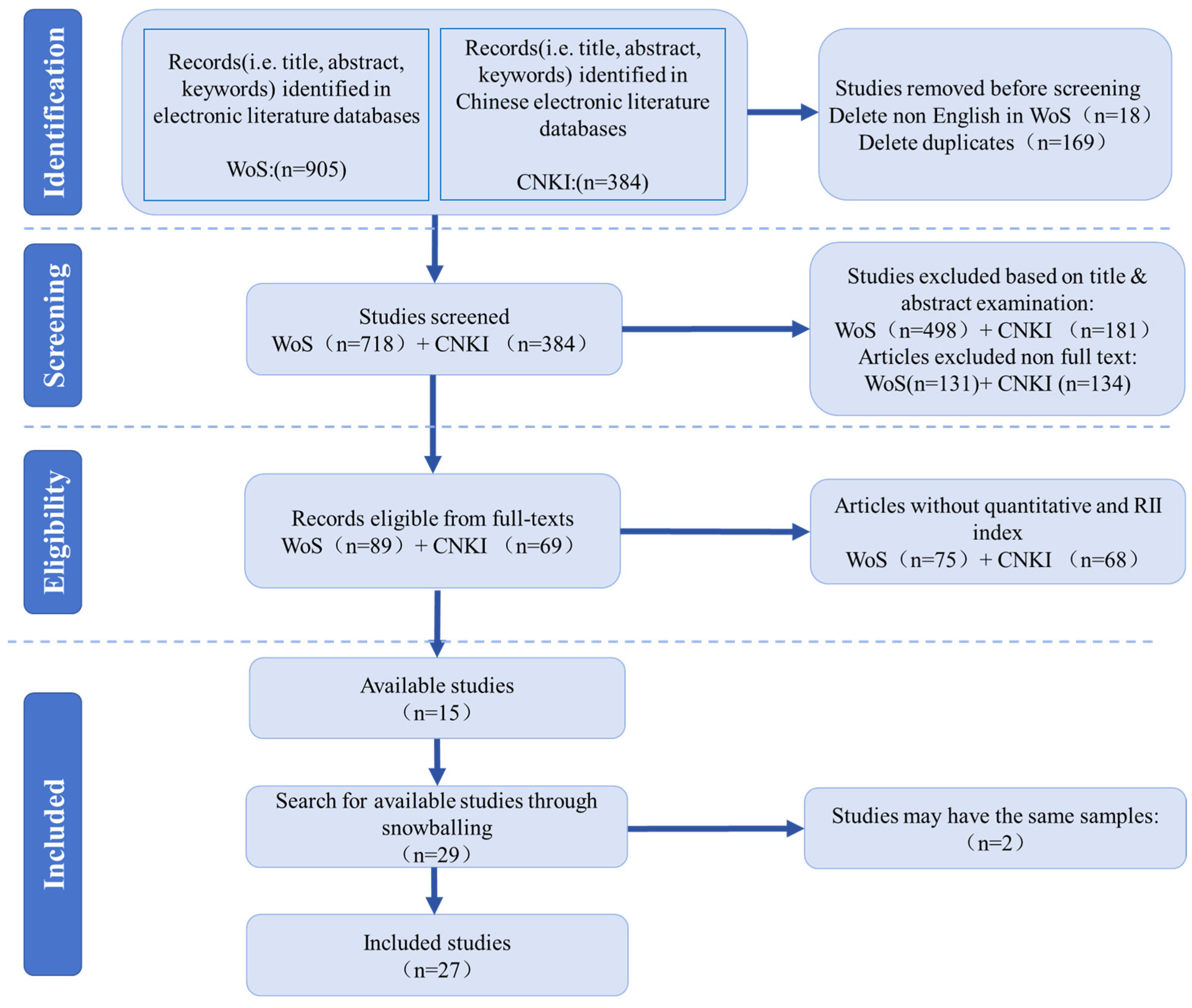
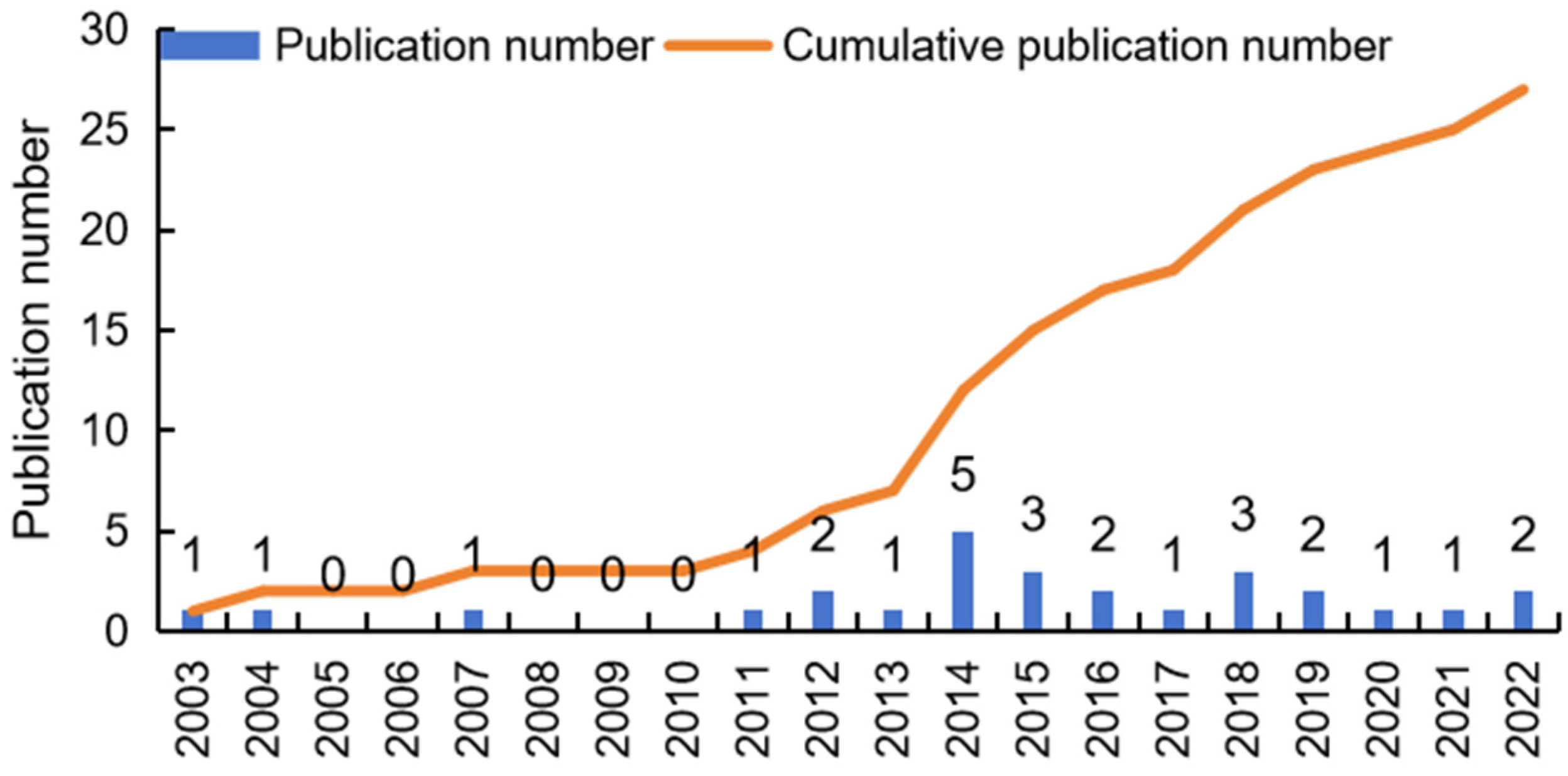
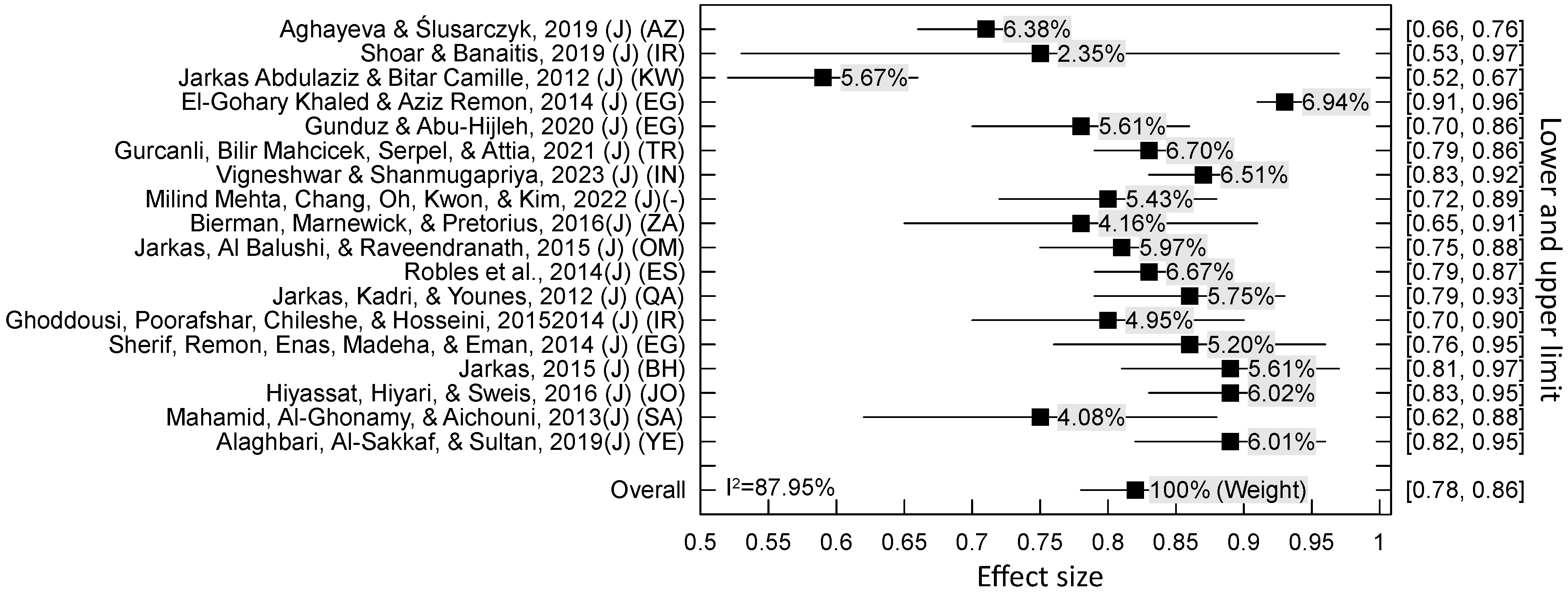
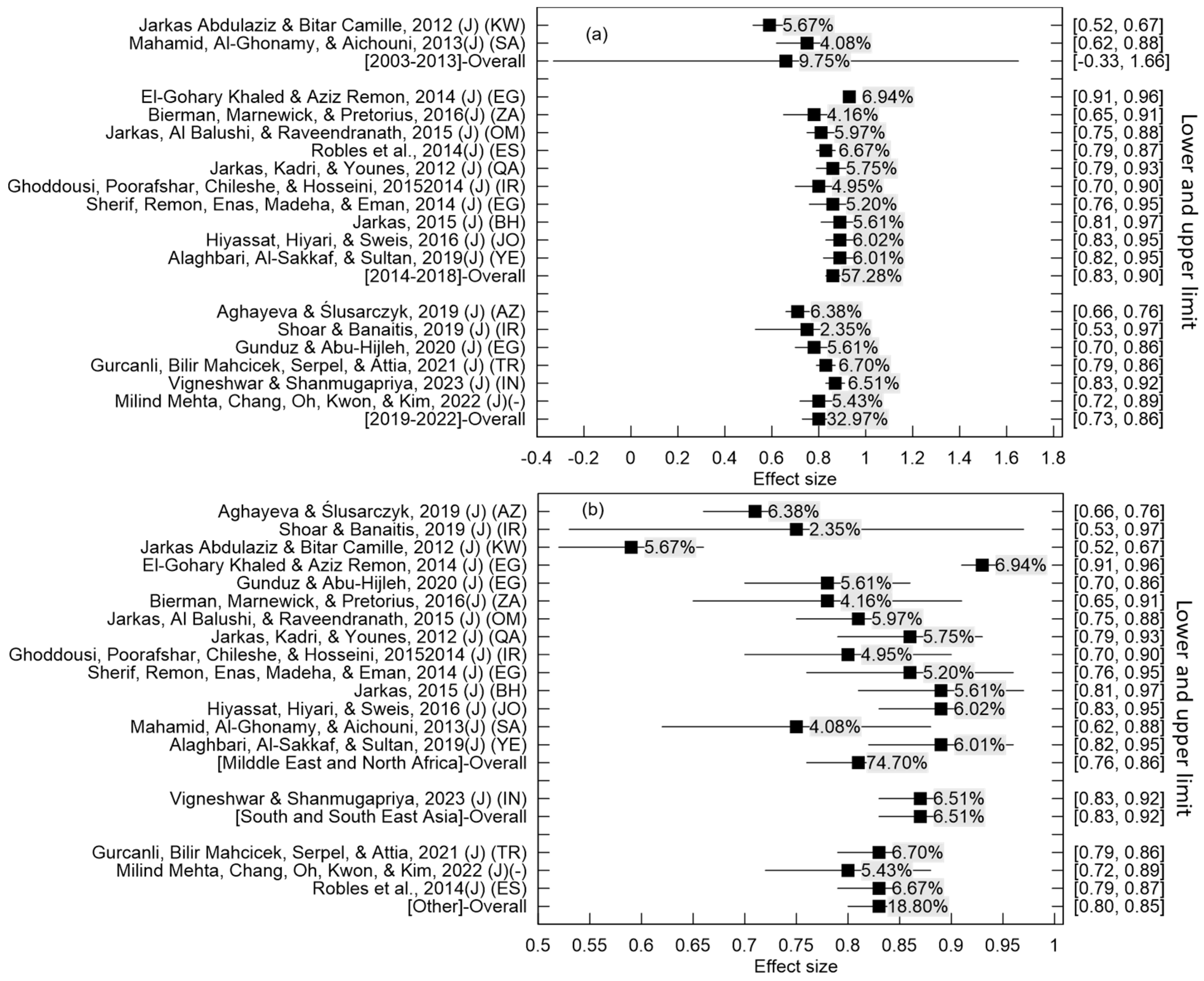
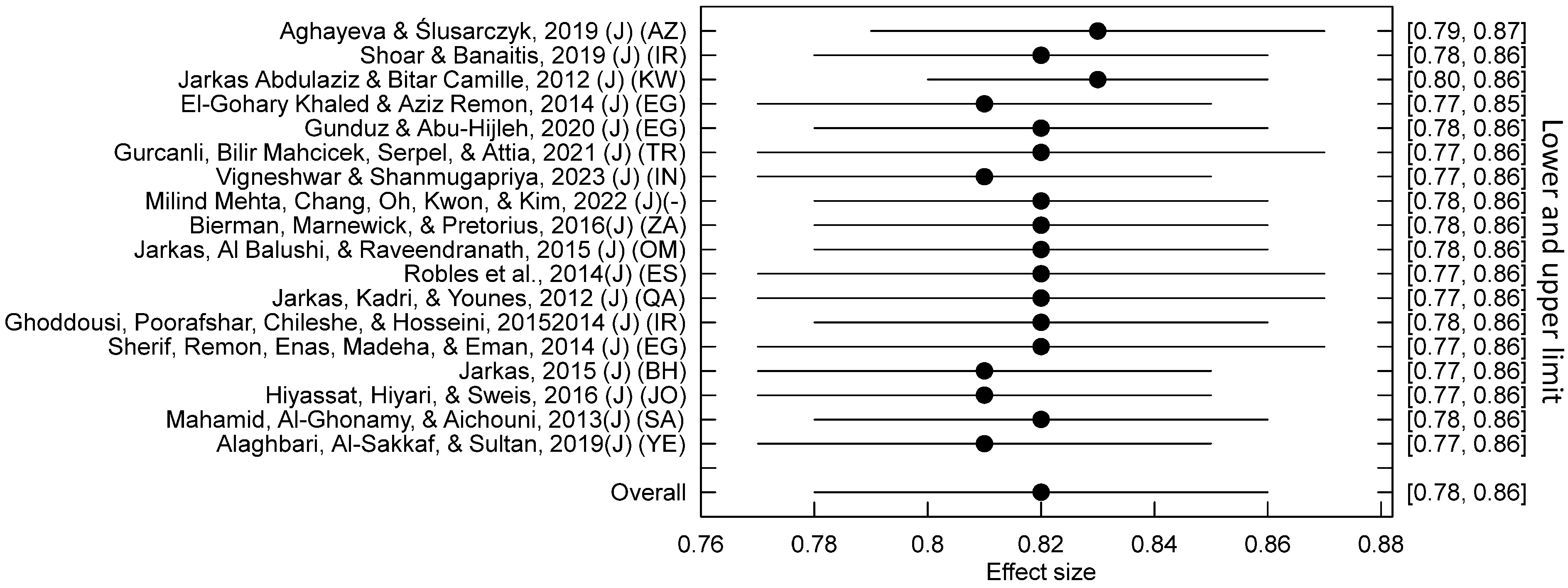
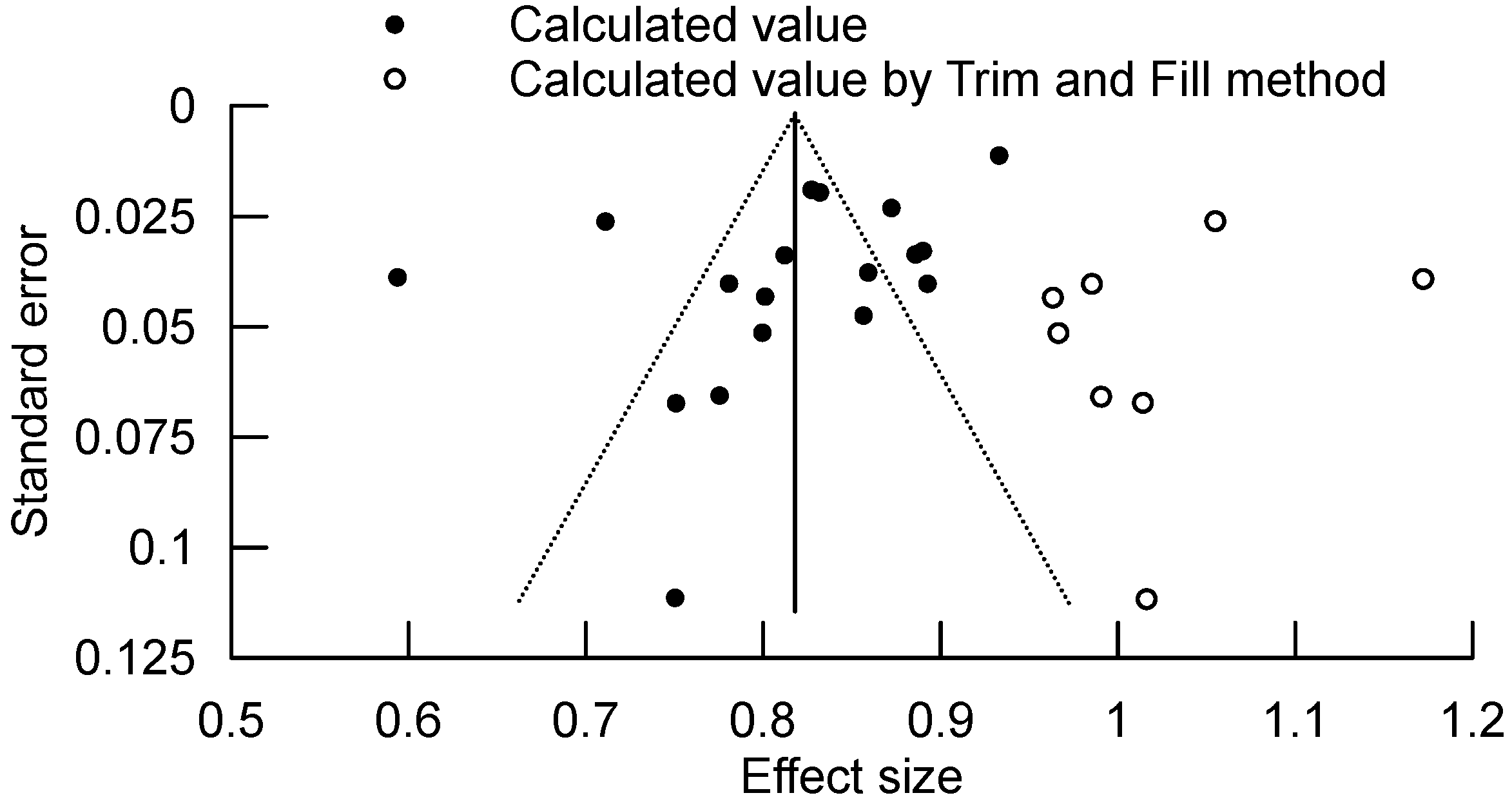

| A Literature Number | Reference | Sample Size | Publication Type | Publication Year | Country |
|---|---|---|---|---|---|
| 1 | Aghayeva and Ślusarczyk, 2019 [25] | 300 | Journal | 2019 | Azerbaijan |
| 2 | Shoar and Banaitis, 2019 [14] | 15 | Journal | 2019 | Iran |
| 3 | Jarkas Abdulaziz and Bitar Camille, 2012 [26] | 157 | Journal | 2012 | Kuwait |
| 4 | El-Gohary Khaled and Aziz Remon, 2014 [27] | 489 | Journal | 2014 | Egypt |
| 5 | Gupta et al., 2018 [15] | 151 | Journal | 2018 | India |
| 6 | Gunduz and Abu-Hijleh, 2020 [28] | 105 | Journal | 2020 | Egypt |
| 7 | Gurcanli et al., 2021 [29] | 400 | Journal | 2021 | Turkish |
| 8 | Vigneshwar and Shanmugapriya, 2023 [9] | 204 | Journal | 2022 | India |
| 9 | Milind Mehta et al., 2022 [30] | 84 | Journal | 2022 | - |
| 10 | Bierman et al., 2016 [31] | 40 | Journal | 2016 | South Africa |
| 11 | Doloi, 2007 [32] | 100 | Journal | 2015 | Australia |
| 12 | Kazaz and Ulubeyli, 2007 [33] | 82 | Journal | 2007 | Turkey |
| 13 | Jarkas et al., 2015 [34] | 132 | Journal | 2015 | Oman |
| 14 | Robles et al., 2014 [13] | 367 | Journal | 2014 | Spain |
| 15 | Jarkas et al., 2012 [35] | 84 | Journal | 2014 | Qatar |
| 16 | Ohueri et al., 2018 [36] | 90 | Journal | 2018 | Malaysia |
| 17 | Ghoddousi et al., 2015 [37] | 60 | Journal | 2014 | Iran |
| 18 | Dixit et al., 2018 [38] | 112 | Non-periodical | 2018 | India |
| 19 | Sherif et al., 2014 [39] | 55 | Journal | 2014 | Egypt |
| 20 | Jarkas, 2015 [40] | 59 | Journal | 2015 | Bahrain |
| 21 | Hiyassat et al., 2016 [41] | 90 | Journal | 2016 | Jordan |
| 22 | Mahamid et al., 2013 [42] | 41 | Journal | 2013 | Saudi Arabia |
| 23 | Arun Makulsawatudom and Emsley, 2002 [43] | 34 | Non-periodical | 2004 | Thailand |
| 24 | Arun Makulsawatudom and Emsley, 2012 [44] | 57 | Non-periodical | 2003 | Thailand |
| 25 | Alaghbari et al., 2019 [45] | 91 | Journal | 2017 | Yemen |
| 26 | Soekiman et al., 2011 [46] | 63 | Journal | 2011 | Indonesia |
| 27 | Qiu, 2012 [47] | 57 | Non-periodical | 2012 | China |
| Category | Factor ID | CF | Frequency | A Literature Number |
|---|---|---|---|---|
| C1 Materials and Equipment | CF1 | Availability of Materials | 18 | 1, 3, 4, 7, 8, 10, 12, 13, 14, 15, 18, 19, 20, 22, 23, 24, 25, 27 |
| CF2 | Availability of Tools and Equipment | 17 | 1, 2, 3, 6, 7, 8, 10, 14, 15, 16, 20, 21, 22, 23, 24, 25, 27 | |
| C2 Project Type | CF3 | Constructability | 3 | 4, 8, 16 |
| CF4 | Project Scale | 4 | 4, 14, 22, 25 | |
| C3 Work Motivation | CF5 | Worker Satisfaction | 6 | 1, 6, 7, 12, 16, 17 |
| CF6 | Occupational Security | 8 | 1, 5, 6, 11, 12, 16, 17, 18 | |
| CF7 | Incentive | 14 | 3, 4, 5, 10, 11, 12, 14, 15, 16, 17, 20, 21, 22, 25 | |
| CF8 | Workers’ Work Enthusiasm | 10 | 2, 3, 7, 9, 10, 13, 14, 15, 19, 20 | |
| CF9 | Promotion Opportunities | 5 | 1, 5, 11, 16, 17 | |
| CF10 | Worker Recognition | 6 | 3, 5, 6, 7, 11, 16 | |
| C4 Labor-Related Factors | CF11 | Lack of Labor | 5 | 3, 4, 6, 21, 22 |
| CF12 | Worker Experience and Skills | 18 | 1, 2, 3, 4, 6, 7, 8, 9, 10, 13, 14, 15, 17, 19, 20, 21, 22, 25 | |
| CF13 | Fatigue | 9 | 2, 3, 6, 7, 10, 13, 15, 19, 20 | |
| CF14 | Worker Age | 4 | 4, 11, 21, 25 | |
| CF15 | Education Level | 5 | 4, 10, 11, 21, 25 | |
| CF16 | Worker Education and Training | 13 | 1, 2, 3, 5, 6, 7, 10, 12, 15, 16, 17, 18, 21 | |
| CF17 | Workers’ Sense of Responsibility | 4 | 1, 12, 16, 17 | |
| CF18 | Worker Absenteeism | 9 | 6, 7, 10, 18, 22, 23, 24, 25, 26 | |
| CF19 | Crew Size and Composition | 10 | 1, 3, 6, 7, 10, 12, 13, 18, 19, 20 | |
| CF20 | Wage Level | 8 | 1, 5, 7, 12, 17, 22, 25.27 | |
| CF21 | Delay in Payments | 13 | 1, 2, 3, 6, 7, 8, 12, 13, 14, 15, 17, 19, 20 | |
| CF22 | Overtime | 13 | 1, 2, 3, 4, 6, 12, 13, 14, 15, 19, 20, 23, 25 | |
| CF23 | Workload | 4 | 4, 7, 24, 25 | |
| C5 Site Management | CF24 | Clarity of Instructions and Communication on the Site | 3 | 4, 25, 26 |
| CF25 | Incompetent Supervisors | 18 | 1, 2, 3, 4, 6, 7, 8, 12, 13, 14, 15, 16, 20, 22, 23, 24, 25, 26 | |
| CF26 | Construction Managers’ Lack of Leadership | 15 | 1, 2, 3, 4, 6, 10, 12, 15, 16, 17, 18, 19, 22, 24, 27 | |
| CF27 | Unsuitability of Storage Location | 8 | 3, 6, 14, 15, 18, 19, 22, 26 | |
| CF28 | Lack of Transportation | 6 | 3, 5, 7, 11, 15, 20 | |
| CF29 | Site Layout | 10 | 2, 3, 8, 10, 12, 13, 19, 20, 23, 24 | |
| CF30 | Distance to Construction Site | 4 | 1, 4, 12, 14 | |
| CF31 | Interference | 6 | 3, 6, 7, 20, 23, 24 | |
| CF32 | Interrupt | 5 | 4, 7, 8, 12, 25 | |
| CF33 | Inspection | 15 | 3, 6, 8, 9, 10, 13, 15, 17, 18, 19, 20, 22, 23, 24, 26 | |
| CF34 | Quality of Site Management | 3 | 7, 8, 21 | |
| CF35 | Competition | 4 | 12, 17, 21, 25 | |
| C6 Stakeholders | CF36 | Delay in Responding to “Requests for Information” | 6 | 3, 6, 10, 13, 15, 20 |
| CF37 | Cooperation of Participants | 9 | 1, 3, 7, 9, 13, 14, 15, 19, 20 | |
| CF38 | Lack of Communication | 18 | 1, 2, 3, 6, 7, 9, 10, 13, 14, 15, 17, 18, 20, 21, 22, 23, 24, 27 | |
| CF39 | Periodical Report and Share Problem | 4 | 3, 6, 17, 18 | |
| CF40 | Workers’ Participation in Decision Making | 3 | 1, 12, 17 | |
| CF41 | Proportion of Work Subcontracted | 7 | 3, 6, 10, 15, 19, 20, 27 | |
| C7 Macro Factors | CF42 | Politics | 3 | 6, 25, 27 |
| CF43 | Economy | 6 | 2, 4, 8, 9, 10, 25 | |
| CF44 | Cultural | 3 | 1, 8, 12 | |
| C8 Climatic Conditions | CF45 | Weather Condition | 11 | 2, 4, 6, 8, 12, 13, 17, 20, 21, 23, 24 |
| CF46 | Temperature | 6 | 3, 10, 14, 15, 19, 25 | |
| CF47 | Humidity | 4 | 3, 14, 15, 19 | |
| CF48 | Wind | 5 | 3, 10, 14, 15, 19 | |
| CF49 | Rain | 5 | 3, 10, 14, 15, 19 | |
| C9 Techniques and Methods | CF50 | Utilizing Advanced Techniques and Technology | 5 | 8, 17, 21, 25, 27 |
| CF51 | Method of Construction | 12 | 2, 3, 4, 6, 7, 8, 13, 14, 15, 18, 19, 20 | |
| CF52 | Design Complexity | 7 | 3, 12, 13, 14, 15, 19, 20 | |
| CF53 | Sequencing Problems | 6 | 3, 7, 13, 15, 20, 21 | |
| CF54 | Clarity of Technical Specification | 9 | 2, 3, 6, 13, 15, 19, 20, 23, 24 | |
| C10 Schedule Planning and Rework | CF55 | Unrealistic Schedule | 10 | 2, 3, 7, 9, 13, 14, 19, 20, 22, 26 |
| CF56 | Rework | 16 | 2, 3, 6, 7, 10, 13, 14, 15, 17, 18, 19, 20, 22, 23, 24, 27 | |
| CF57 | Lack of Planning | 6 | 7, 8, 10, 14, 18, 25 | |
| CF58 | Change Orders | 16 | 2, 3, 6, 7, 8, 10, 13, 15, 18, 19, 20, 22, 23, 24, 26, 27 | |
| C11 Site Working Conditions | CF59 | Safe Working Conditions | 5 | 7, 9, 12, 16, 17 |
| CF60 | Interpersonal Relationship | 6 | 1, 12, 16, 17, 22, 25 | |
| CF61 | Unforeseen Ground Conditions | 3 | 6, 13, 20 | |
| CF62 | Site Congestion | 14 | 3, 4, 5, 7, 9, 10, 12, 13, 14, 15, 17, 20, 23, 24 | |
| CF63 | Confinement of Working Space | 7 | 3, 13, 14, 15, 18, 20, 22 | |
| CF64 | Site Restricted Access | 3 | 3, 15, 19 | |
| CF65 | Safety Accidents | 9 | 3, 7, 10, 13, 19, 20, 23, 24, 27 | |
| C12 Social Welfare | CF66 | Social Health and Insurance | 4 | 4, 5, 12, 25 |
Disclaimer/Publisher’s Note: The statements, opinions and data contained in all publications are solely those of the individual author(s) and contributor(s) and not of MDPI and/or the editor(s). MDPI and/or the editor(s) disclaim responsibility for any injury to people or property resulting from any ideas, methods, instructions or products referred to in the content. |
© 2025 by the authors. Licensee MDPI, Basel, Switzerland. This article is an open access article distributed under the terms and conditions of the Creative Commons Attribution (CC BY) license (https://creativecommons.org/licenses/by/4.0/).
Share and Cite
Jian, F.; Liu, Q.; Feng, C.; Hu, Q.; Yu, Q.; Guo, Q. Critical Factors Affecting Construction Labor Productivity: A Systematic Review and Meta-Analysis. Buildings 2025, 15, 2463. https://doi.org/10.3390/buildings15142463
Jian F, Liu Q, Feng C, Hu Q, Yu Q, Guo Q. Critical Factors Affecting Construction Labor Productivity: A Systematic Review and Meta-Analysis. Buildings. 2025; 15(14):2463. https://doi.org/10.3390/buildings15142463
Chicago/Turabian StyleJian, Feihong, Qian Liu, Cong Feng, Qiaoyi Hu, Qishu Yu, and Qi Guo. 2025. "Critical Factors Affecting Construction Labor Productivity: A Systematic Review and Meta-Analysis" Buildings 15, no. 14: 2463. https://doi.org/10.3390/buildings15142463
APA StyleJian, F., Liu, Q., Feng, C., Hu, Q., Yu, Q., & Guo, Q. (2025). Critical Factors Affecting Construction Labor Productivity: A Systematic Review and Meta-Analysis. Buildings, 15(14), 2463. https://doi.org/10.3390/buildings15142463






